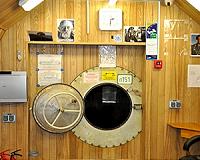 |
Moscow (AFP) June 3, 2010 Six men from Europe, Russia and China will on Thursday be voluntarily locked away in a module for almost one and a half years to simulate the psychological effects of a mission to Mars. An Italian, Frenchman, three Russians and a Chinese man will spend the next 520 days in the isolation facility at a Moscow research institute when its hatch slams shut at 2:00 pm (1000 GMT). Like a real Mars mission, the crew will have to survive on limited food rations and their only communication with the outside world will be by email, with a delay of up to 40 minutes. The hatch will only re-open when the experiment is over or if one of the participants is forced to pull out. "It will be trying for all of us. We cannot see our family, we cannot see our friends, but I think it is all a glorious time in our lives," said Chinese participant Wang Yue, 27, ahead of the experiment. The volunteers will have their days in the module at the Russian Institute for Biomedical Problems (IBMP) divided into eight hours of sleep, eight hours of work and eight hours of leisure. A team of three will spend one month aboard a special module meant to represent the Mars landing craft, while two will also spend time exploring a reconstruction of Mars itself. The idea is to exactly mimic the timescale of a Mars mission -- 250 days for the trip to Mars, 30 days on the surface and 240 days for the return journey, totalling 520 days. The crew also conspicuously lacks women, meaning the experiment will not be able to examine the possible sexual tensions that could arise on a trip to Mars for a mixed-gender crew. But volunteers have already admitted that they will be tested by being separated from their loved ones and partners for such a long period of time. Frenchman Romain Charles, 31, said the hardest thing will be the disruption of contact "with the family, the girlfriend, the friends with whom the distance is going to be difficult to manage." Their diet will be no different to that enjoyed by real-life astronauts on the International Space Station and the crew will be given the food at the beginning of the experiment, forcing them to ration out their supplies. The experiment is a joint venture between the IBMP and the European Space Agency (ESA), which describes the project as a mission "to mimic a full mission to Mars and back as accurately as possible without actually going there." The ESA and the US space agency NASA have separately sketched dates in around three decades from now for a manned flight to Mars. The Red Planet's distance from Earth varies between 55 million kilometres (34 million miles) and more than 400 million kilometres (250 million miles), depending on where the two planets are in their respective orbits. The project, the first full-duration simulated mission to Mars, follows a similar experiment at the (IBMP) last year which saw six volunteers shut away for a mere 105 days.
Share This Article With Planet Earth
Related Links Mars News and Information at MarsDaily.com Lunar Dreams and more
 520 Days On A Simulated Flight To Mars
520 Days On A Simulated Flight To MarsBonn, Germany (SPX) Jun 02, 2010 On 3 June 2010, six 'astronauts' will commence a virtual trip to Mars. Sealed into a cramped container at the Moscow Institute of Biomedical Problems (IBMP) for 520 days, they will experience the rigours and isolation of long-duration spaceflight. This marks the start of the main part of the Mars 500 experiment, and on completion will constitute the longest ever space simulation experiment. ... read more |
|
| The content herein, unless otherwise known to be public domain, are Copyright 1995-2010 - SpaceDaily. AFP and UPI Wire Stories are copyright Agence France-Presse and United Press International. ESA Portal Reports are copyright European Space Agency. All NASA sourced material is public domain. Additional copyrights may apply in whole or part to other bona fide parties. Advertising does not imply endorsement,agreement or approval of any opinions, statements or information provided by SpaceDaily on any Web page published or hosted by SpaceDaily. Privacy Statement |